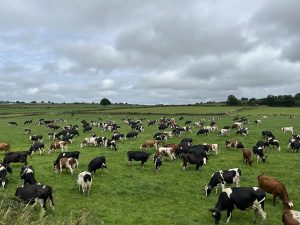
This rare market situation has resulted in high milk prices across most export regions, at record levels in some regions, but there are now signs of change.
Rabobank, a global lender to food and agriculture, expects the combined Big-7 milk pool to return to growth between now and the end of this year.
However, it attaches a warning of weather risk to this forecast growth rate, and says growth through 2023 is likely to be below the long-term average.
“After more than a year of contraction, Big-7 exportable surpluses will also increase year-on-year from Q4 2022 onward”, predict the bank’s analysts.
Slightly increased milk supply and sluggish dairy demand in home markets are forecast to leave exportable surpluses expanding into the first half of 2023 for the “Big-7” (the US, the EU, New Zealand, Australia, Brazil, Argentina, and Uruguay).
Globally, feed prices have fallen, This helps dairy farmers, but weather risks linger. The Ukraine grain corridor opening, and Russian exports, eased feed prices. But extreme heat in the US has threatened crops, and EU spring crops also suffered from unfavorable weather. More disruption to Black Sea trade is still possible, which could lift feed prices.
“However, there are already signs that the milk price cycle has peaked”, said analysts.
In the EU, the story could be different, if the widespread drought leaves its mark on dairy farms. EU data indicated drought conditions worsening for most of Europe throughout August.
Burned pastures
There have been widespread reports of dairy and beef farmers with parched and burned pastures, forced to eat into winter reserves of forage even before the summer was over.
In July, milk output in the UK hit a five-year low.
Europe’s energy crisis and weak milk supply heading into the Northern Hemisphere winter could underpin current high milk prices, particularly if Chinese demand rebounds after Covid-19 lockdowns.
The major region likely to contribute quickly to predicted milk growth is the US, where growth was better than expected in June, with rising cow numbers and yields. Nevertheless, US milk production in 2022 up to July was down by 0.6% from 12 months previously.
New Zealand milk production for July 2022 dropped by almost 6% compared to last year. For the first two months of the 2022/23 season, milk collections are 3.2% behind last year. There are lingering impacts from an extended, very dry autumn in the Waikato area, with variable weather elsewhere. The dairy calving season in some other regions was hit by rain and floods.
Milk growth is not forecast for Australia.
Record prices
In many regions, record high milk prices are not leading to a recovery in production growth.
Dairy farmers globally are confronted with new regulations and climate action.
On the demand side, deteriorating economic conditions may reduce dairy product sales, and Rabobank predicts reduced Chinese buying of dairy products to continue into 2023.
But there was little sign of that, so far in September, nor of the longer-term Rabobank prediction of milk growth.
Instead, as if to emphasise the volatility of dairy markets, the Rabobank forecast coincided with global dairy prices ending a long losing streak last week in the global dairy trading auction (GDT).
Prices in this auction hit record levels in March, but slipped 25% since then, possibly due to Covid-19 disruptions and worsening global economic conditions. In the latest auction, the Global Dairy Trade price index rose 4.9%.
It provided proof of demand even at current high prices,with the market not sitting back and waiting for milk growth.
However, the main commodities were sold last week at prices about 25% back from the March peak.

























